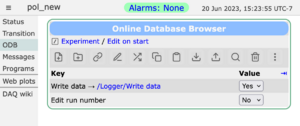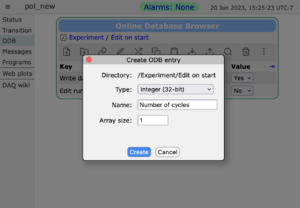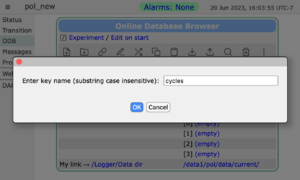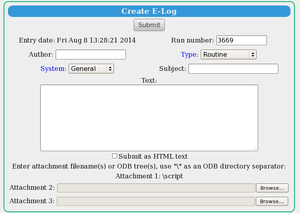ODB Page: Difference between revisions
No edit summary |
No edit summary |
||
| Line 35: | Line 35: | ||
<div id="Figure 2"></div> | <div id="Figure 2"></div> | ||
[[File:odb_page_list.png|thumb|left|Figure 2: ODB Page Listing]] | [[File:odb_page_list.png|thumb|left|Figure 2: ODB Page Listing]] | ||
By clicking on the key-links on the ODB page ([[#Example ODB Page|Figure 1]]), the user can browse the various subtrees. By clicking on the "+" link adjacent to the "Value" heading ([[#Figure 2|Figure 2]]) , the type and size of the keys are shown. This is equivalent to the [[odbedit]] commands "ls" | By clicking on the key-links on the ODB page ([[#Example ODB Page|Figure 1]]), the user can browse the various subtrees. By clicking on the "+" link adjacent to the "Value" heading ([[#Figure 2|Figure 2]]) , the type and size of the keys are shown. This is equivalent to the [[odbedit]] commands <span style="color:saddlebrown; ">ls</span> and <span style="color:saddlebrown;">ls -l</span>. | ||
<br clear=all> | <br clear=all> | ||
By clicking on a key, the user can change the value (unless password-protected or the key is write-protected - see [[Security]]). If web access is restricted, the user will be asked for a password the first time he/she attempts to edit a value. | |||
By clicking on a key, the user can change the value (unless the | |||
= Create a key = | = Create a key = | ||
Revision as of 21:01, 8 August 2014
Links
Purpose
The purpose of the mhttpd ODB page is to allow the user to browse, search and edit the ODB of an experiment. This gives a graphical alternative to using the ODB editor odbedit.
Access the ODB page
The ODB Page is accessed from the Status Page (or any of the other Pages) by clicking on the menu-button ODB. The top level ODB trees will be visible as key-links (i.e.links to a key) (Figure 1).
Browse the ODB
By clicking on the key-links on the ODB page (Figure 1), the user can browse the various subtrees. By clicking on the "+" link adjacent to the "Value" heading (Figure 2) , the type and size of the keys are shown. This is equivalent to the odbedit commands ls and ls -l.
By clicking on a key, the user can change the value (unless password-protected or the key is write-protected - see Security). If web access is restricted, the user will be asked for a password the first time he/she attempts to edit a value.
Create a key
The user can create a new key in a tree or subtree by clicking the Create button. The Type of key to be created is selected from the drop-down list (Figure 3). The choices are:
| Key Types | |
| Integer(32-bit) | Float (4 bytes) |
| String | Multi-line String |
| Subdirectory | Byte |
| Signed byte | Character (8-bit) |
| Word (16-bit) | Short integer(16-bit) |
| Double Word (32-bit) | Boolean |
| Double float(8 Bytes) | Symbolic link |
Delete a key
The user can delete a key in a tree or subtree by clicking the Delete button. The user selects which to delete from a list of the keys in the subtree (e.g. Figure 4).
Search the ODB for a key
Click on the Find button. A pop-up (Figure 5) appears in which the user types the relevant information.
Create Elog entry
An elog entry can be created easily from the ODB page by clicking the Create Elog from this page button. A pop-up will appear for the user to fill in (Figure 6).
Limitations
The ODB Page editor supports a subset of the functionality of odbedit. For example, the ODB Page editor does not support re-ordering or renaming ODB keys. For full editing capabilities odbedit must be used.





